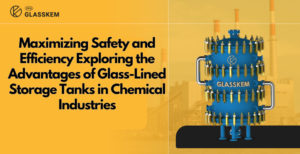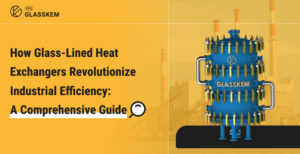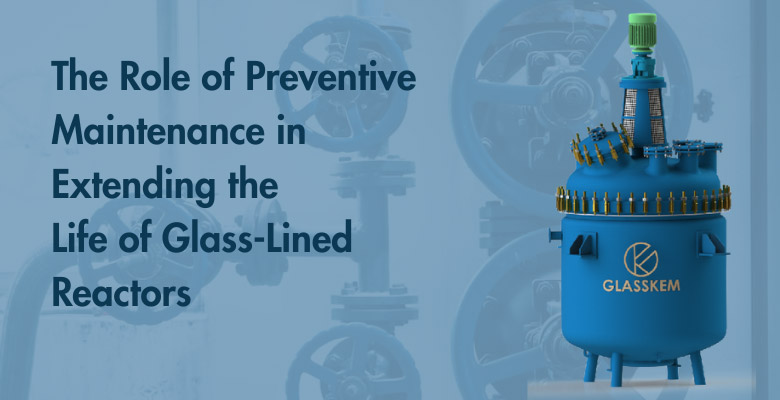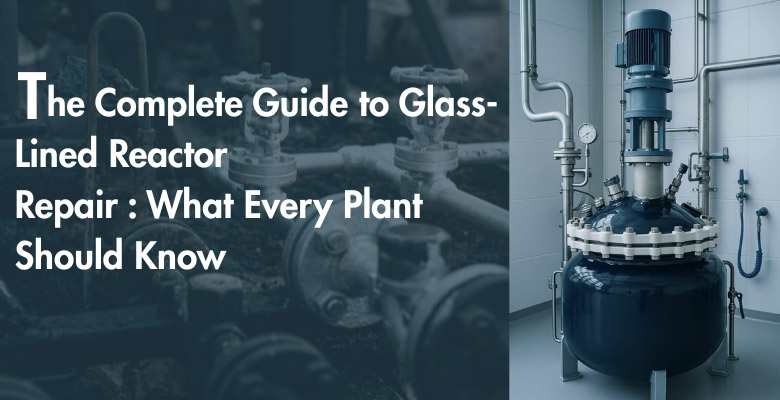Product Guide
The Role of Preventive Maintenance in Extending theLife of Glass-Lined Reactors
The Role of Preventive Maintenance in Extending the Life of...
Read MoreThe Complete Guide to Glass-Lined Reactor Repair:What Every Plant Should Know
The Complete Guide to Glass-Lined Reactor Repair: What Every Plant...
Read MoreMaximizing Safety and Efficiency: Exploring the Advantages of Glass-Lined Storage Tanks in Chemical Industries
Maximizing Safety and Efficiency: Exploring the Advantages of Glass-Lined Storage...
Read MoreHow Glass-Lined Heat Exchangers Revolutionize Industrial Efficiency: A Comprehensive Guide
How Glass-Lined Heat Exchangers Revolutionize Industrial Efficiency: A Comprehensive Guide...
Read MoreThe Role of Preventive Maintenance in Extending theLife of Glass-Lined Reactors
The Role of Preventive Maintenance in Extending the Life of Glass-Lined Reactors Glass-lined reactors are critical assets in industries like pharmaceuticals, chemicals, and food processing, where corrosion resistance and purity are essential. Despite their durability, these reactors are not immune to wear and damage. That’s where preventive maintenance plays a vital role—helping plants avoid costly downtime, extend equipment life, and ensure operational safety. Why Preventive Maintenance Matters Unlike reactive maintenance, which addresses problems after they occur, preventive maintenance is a proactive strategy. It involves regularly scheduled inspections and upkeep to detect early signs of wear or damage before they lead to equipment failure.For glass-lined reactors, this is especially important because: Minor defects can escalate quickly due to exposure to harsh chemicals. Unnoticed damage can contaminate batches, leading to product loss. Unexpected failure results in production delays and high repair costs. Key Components of Preventive Maintenance for Glass-LinedReactors 1. Regular Inspections Routine visual inspections and spark testing should be carried out at scheduled intervals. Look for: Chips, cracks, or blisters on the glass lining Rust or corrosion near nozzles or manways Any changes in reactor performance or pressure readings 2. Cleaning and Decontamination Clean the reactor using approved methods and tools that do not damage the glass lining. Avoid abrasive materials and harsh chemicals not compatible with the enamel. 3. Monitoring Process Conditions Track temperature, pressure, and pH levels to ensure they remain within the reactor’s specified limits. Rapid temperature changes and aggressive media can damage the lining over time. 4. Torque Checks and Fastener Maintenance Regularly check and retorque bolts and fasteners on flanged connections to prevent leaks and mechanical stress on the lining. 5. Documentation and Record Keeping Maintain logs of inspections, repairs, and maintenance activities. This helps in identifying trends and planning future maintenance schedules more effectively. 6. Training for Operators and Maintenance Staff Ensure that everyone handling the reactor understands proper operating procedures, cleaning protocols, and the importance of gentle handling to avoid mechanical damage. Protect Your Glass-Lined Investment — Book a Reactor Health Check with Our Experts. Benefits of Preventive Maintenance Increased Equipment Lifespan: Well-maintained reactors last significantly longer, delivering better ROI. Reduced Downtime: Early detection of issues prevents unscheduled outages. Cost Savings: Avoids major repairs and replacements through timely interventions. Improved Safety: Reduces risk of accidents caused by leaks or equipment failure. Consistent Product Quality: Keeps contamination risks at bay. Conclusion Preventive maintenance is not just a best practice—it’s a necessity for plants relying on glass-lined reactors. With regular inspections, proper handling, and timely interventions, you can protect your equipment, ensure smooth operations, and maximize the lifecycle of your investment. Read More:-HOW GLASS-LINED HEAT EXCHANGERS REVOLUTIONIZE INDUSTRIAL EFFICIENCY: A COMPREHENSIVE GUIDE Category Product Guide Product Review Export Advise Process Technology Work Environment Standers & Protocols & Safety Catelog Recent Posts The Advantages of Glass-Lined Equipment in Industrial Processes The Importance of Glass Lined Reactors in the Chemical Process Industries Glass Lined Equipment Maintenance: Tips and Best Practices The Future of Glass-Lined Equipment: Trends and Innovations to Watch
The Complete Guide to Glass-Lined Reactor Repair:What Every Plant Should Know
The Complete Guide to Glass-Lined Reactor Repair: What Every Plant Should Know Glass-lined reactors are essential in industries like chemicals, pharmaceuticals, and food processing. Their glass coating helps protect against corrosion and contamination, making them perfect for handling strong chemicals and clean processes. But like any equipment, they can get damaged over time. Knowing how to repair them properly is important to keep your plant safe, efficient, and within regulations. Why Glass-Lined Reactors Require Special Attention While glass-lined reactors are built for durability, they face challenges such as: Safety Benefits of Glass-Lined Tanks Thermal stress from rapid heating or cooling cycles. Mechanical impact during cleaning or loading/unloading. Chemical attack from incompatible materials. Even small cracks or chips in the glass lining can lead to serious issues like productcontamination, corrosion of the steel substrate, and even equipment failure if leftunaddressed. Common Signs of Damage Early detection is key to effective repair. Look out for: Blisters or bulging on the lining. Visible cracks or chips in the enamel surface. Delamination or flaking of the glass coating. Leaks or pressure drops during operation. Color changes or signs of corrosion around fittings and nozzles. Regular inspection and maintenance help spot these signs before they escalate intomajor problems. Step-by-Step Guide to Glass-Lined Reactor Repair 1. Initial Inspection and Damage Assessment Qualified technicians begin with a visual and spark test to locate defects. A full inspection may involve: UV light or holiday testing Ultrasonic thickness measurements Surface mapping to document the extent of the damage 2. Preparation of the Repair Area Before any repair: The reactor is cleaned and degassed. Damaged areas are marked. Surface preparation includes grinding, sandblasting, or chemical etching to ensure proper adhesion of repair materials. 3. Repair Methods Depending on the severity and location of the defect, common repair methods include: Cold repair compounds (e.g., ceramic-filled epoxies) for minor surface damage. Hot curing enamels for high-performance, durable repairs—often performed in a controlled workshop environment. Spot re-glassing in extreme cases, requiring specialized equipment and conditions. 4. Post-Repair Testing and Validation After repair, the reactor undergoes: Spark testing to ensure continuity of the enamel. Pressure or vacuum testing for leaks. Quality documentation and certification. Choosing the Right Repair Partner Not all repair jobs are equal. Always work with certified professionals experienced in glass-lined equipment. A reputable service provider will offer: Proper certification and safety protocols On-site and o -site repair capabilities Warranties on repair work Recommendations for preventive maintenance Preventive Maintenance Tips To extend the life of your glass-lined reactor: Conduct regular inspections (at least annually) Avoid thermal shock by controlling heating/cooling rates Use only approved cleaning tools and chemicals Train staff on proper handling and maintenance procedures Conclusion Glass-lined reactor repair is not just about fixing a problem, it’s about protecting your plant’s productivity, product integrity, and equipment investment. By understanding the causes of damage, knowing when and how to repair, and implementing a preventive maintenance program, you can ensure your reactor operates safely and efficiently for years to come.Keep your reactor running at its best – schedule maintenance with Glasskem, your reliable partner for expert repair and servicing. Read More:-HOW GLASS-LINED HEAT EXCHANGERS REVOLUTIONIZE INDUSTRIAL EFFICIENCY: A COMPREHENSIVE GUIDE Category Product Guide Product Review Export Advise Process Technology Work Environment Standers & Protocols & Safety Catelog Recent Posts The Advantages of Glass-Lined Equipment in Industrial Processes The Importance of Glass Lined Reactors in the Chemical Process Industries Glass Lined Equipment Maintenance: Tips and Best Practices The Future of Glass-Lined Equipment: Trends and Innovations to Watch
PFG Glasskem Inc’s Success at ChemTECH World Expo 2024: Showcasing Innovation in Glass-Lined Reactors
PFG Glasskem Inc’s Success at ChemTECH World Expo 2024: Showcasing Innovation in Glass-Lined Reactors https://youtu.be/xoqKRBwBZTMPFG Glasskem Inc. recently participated in the esteemed ChemTECH World Expo, held in Mumbai, India, from March 4-7, 2024. This event served as a platform for us to exhibit our state-of-the-art glass-lined reactors and related equipment, and we are delighted to share the highlights of our experience with you. Glass Lined Reactors Glass-lined reactors are a critical component in the chemical and pharmaceutical industries, and they are used for various processes such as mixing, reaction, distillation, and crystallization. They are constructed with a glass lining applied to the interior surface of the reactor vessel, providing a durable, non-corrosive, and contamination-resistant solution for handling a wide range of chemicals and processes. Types of Glass Lined Reactors Jacketed Reactors: These reactors feature a jacket surrounding the vessel, allowing for the circulation of heating or cooling fluids to regulate the temperature of the contents. Unjacketed Reactors: In unjacketed reactors, the vessel is the primary heat transfer surface, making them suitable for processes that do not require precise temperature control. Features of Glass Lined Reactors Corrosion Resistance: The glass lining protects the reactor from corrosion, ensuring a long service life and maintaining product purity. Thermal Shock Resistance: Glass-lined reactors can withstand rapid temperature changes, making them suitable for processes that require heating or cooling cycles. Easy Cleaning: The smooth, non-porous surface of the glass lining is easy to clean and sterilize, minimizing the risk of contamination between batches. Versatility: Glass-lined reactors are versatile and can be used for various processes across various industries, including pharmaceuticals, chemicals, and food processing. Safety: The glass lining provides a barrier between the process fluid and the reactor vessel, ensuring the safe containment of hazardous materials. At the ChemTECH World Expo, our glass-lined reactors garnered significant attention for their innovative design, advanced features, and exceptional performance. Visitors were impressed by the quality and reliability of our products and recognized them as a valuable addition to their operations. We want to extend our sincere gratitude to all the visitors who visited our booth at the expo. Your interest and support motivate us to continue innovating and delivering excellence in glass-lined equipment. As we look ahead, we are excited about the opportunities and remain committed to providing innovative solutions that meet our customers’ evolving needs. Thank you for being a part of our journey. Category Product Guide Product Review Export Advise Process Technology Work Environment Standers & Protocols & Safety Catelog Recent Posts The Advantages of Glass-Lined Equipment in Industrial Processes The Importance of Glass Lined Reactors in the Chemical Process Industries Glass Lined Equipment Maintenance: Tips and Best Practices The Future of Glass-Lined Equipment: Trends and Innovations to Watch











